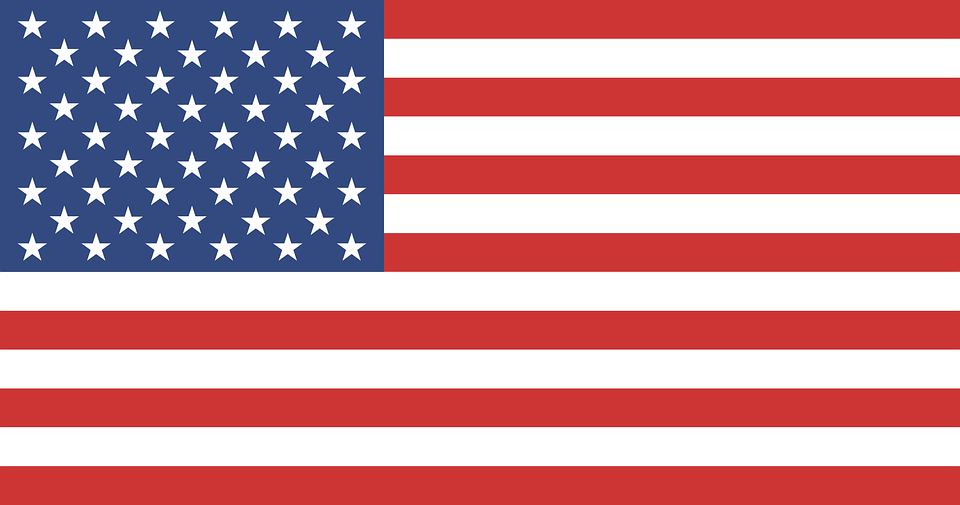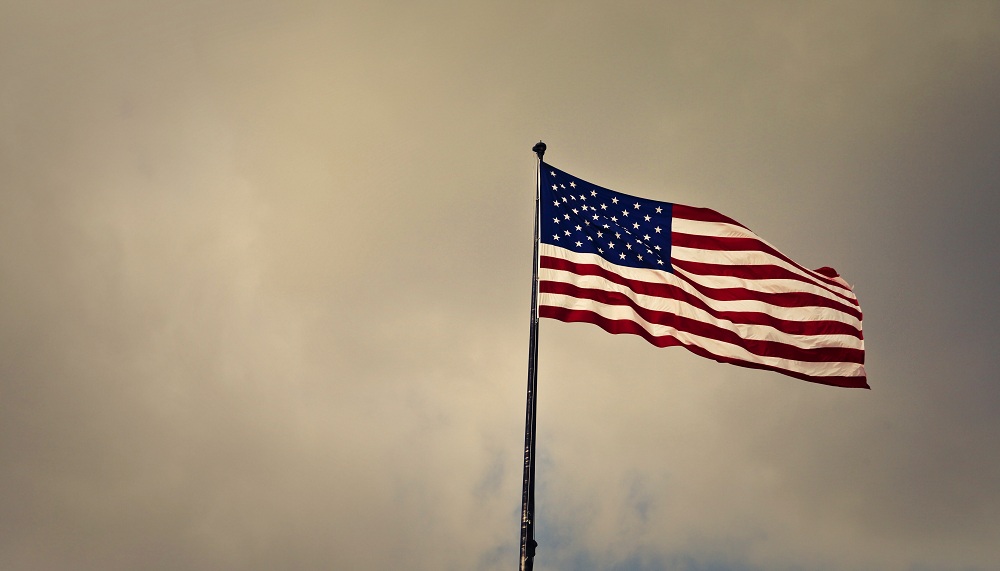Arguably one of the most recognizable flags in the entire world, the flag of the United States of America has different meanings to different people: some see it as a symbol of freedom and democracy, while others may disagree.
To get a better understanding of Old Glory’s symbolism, it’s best to look at it through the lens of history.
History and Design
Prior to the Declaration of Independence in 1776, the Thirteen Colonies used the flag of Great Britain. In 1775, during the War of Independence, the Continental Congress was operating as a war government that created an army, navy, and marine corps distinct from England. As such, it needed to create a flag that would distinguish it from the United Kingdom.
The first real “national” flag was the Continental Colors, also known as the Grand Union Flag. The Continental Navy would be the first to raise the Continental Colors, aboard the colonial warship Alfred. The Continental Colors were strikingly similar to the British East India Company flag, which also consisted of 13 alternating red and white stripes with the British Union flag on the upper left canton.
To remedy this, the Second Continental Congress enacted the Flag Resolution on June 14th, 1777. This resolution sought to create a national flag for the new nation that was completely distinct from other flags, stating: “That the flag of the thirteen United States be thirteen stripes, alternate red and white; that the union be thirteen stars, white in a blue field, representing a new constellation”. On August 3, 1777, the first official flag of the United States was flown in battle during the Siege of Fort Stanwix, with soldiers using scraps of cloth from their own uniforms.
The 1777 resolution, however, did not give specific measurements or prescriptions on arrangement or orientation. To give it uniformity, Francis Hopkins, a signatory of the Declaration of Independence, designed the 1777 flag, which became the framework for subsequent flags in the future.
As states were added to the United States, more stars were added to the upper left canton, with the country updating its flag every time a state enters the union. The current flag, which portrays 50 stars, is the longest-running flag of the United States, serving from 1960 to present.
Variations
Aside from the different flags that the country had to adopt with every new state, variations of the “star and stripes” have existed since its inception. Here are just a few examples:
Rebellious Stripes:
 Prior to the Revolutionary War, the secret society called the Sons of Liberty created the “rebellious stripes” flag, which contained 9 vertical stripes of alternating colors (red and white).
Prior to the Revolutionary War, the secret society called the Sons of Liberty created the “rebellious stripes” flag, which contained 9 vertical stripes of alternating colors (red and white).
Serapis:
During the famous naval Battle of Flamborough Head, U.S Naval Captain John Paul J ones captured the British warship Serapisafter his own ship, the Bonhomme Richard, sank, along with the ship’s ensign. John Paul Jones then sailed to the island of Texel in the neutral Dutch United Provinces. While docked in Texel, British officials pleaded with the Dutch to surrender John Paul Jones, arguing that his act of sailing a ship with no known national flag is tantamount to piracy. To avoid this, U.S. ambassadors to France Benjamin Franklin and John Adams sent Dutch officials a sketch of a flag to be made for the Serapis, in order to avoid any legal controversy for the neutral nation.
ones captured the British warship Serapisafter his own ship, the Bonhomme Richard, sank, along with the ship’s ensign. John Paul Jones then sailed to the island of Texel in the neutral Dutch United Provinces. While docked in Texel, British officials pleaded with the Dutch to surrender John Paul Jones, arguing that his act of sailing a ship with no known national flag is tantamount to piracy. To avoid this, U.S. ambassadors to France Benjamin Franklin and John Adams sent Dutch officials a sketch of a flag to be made for the Serapis, in order to avoid any legal controversy for the neutral nation.
Betsy Ross:
 One of the earliest designs that used the “stars and stripes” motif, the origin story of the Betsy Ross Flag remains a contentious subject for historians vexillologists. The story goes that a committee consisting of George Washington, Robert Morris, and George Ross visited Elizabeth “Betsy” Ross, an upholstery maker, to design the flag of the United States of America. However, a lack of evidence makes this story unverifiable.
One of the earliest designs that used the “stars and stripes” motif, the origin story of the Betsy Ross Flag remains a contentious subject for historians vexillologists. The story goes that a committee consisting of George Washington, Robert Morris, and George Ross visited Elizabeth “Betsy” Ross, an upholstery maker, to design the flag of the United States of America. However, a lack of evidence makes this story unverifiable.
Bennington:
 Legend has it that the Bennington Flag, one of the more distinctive flags of the revolution thanks to the large “76” on the canton, was flown during the Battle of Bennington. Nathan Fillmore, grandfather of President Millard Fillmore, carried the flag off the battlefield and kept it in his family’s possession for generations. However, many historians doubt this story and attribute the Bennington Flag’s creation to drumming up revolutionary sentiment during the War of 1812.
Legend has it that the Bennington Flag, one of the more distinctive flags of the revolution thanks to the large “76” on the canton, was flown during the Battle of Bennington. Nathan Fillmore, grandfather of President Millard Fillmore, carried the flag off the battlefield and kept it in his family’s possession for generations. However, many historians doubt this story and attribute the Bennington Flag’s creation to drumming up revolutionary sentiment during the War of 1812.
Republic of Libera:
 In 1846, Liberian settlers of American descent declared the Commonwealth of Liberia a free, independent and sovereign state. In honor of their American heritage, the Liberians created a flag modeled after the American flag of the 1820’s.
In 1846, Liberian settlers of American descent declared the Commonwealth of Liberia a free, independent and sovereign state. In honor of their American heritage, the Liberians created a flag modeled after the American flag of the 1820’s.
Bikini Atoll:
 Closely resembling the flag of the United States, with the 23 stars representing the 23 islands of the pacific atoll, and the words “MEN WŌTŌMJEJ REJ ILO PEIN ANIJ” (Everything is in the hands of God), the Bikini Atoll flag was created as a sign of protest and as a symbol of the islander’s belief that the United States owes a huge debt to their islands following the latter’s detonation of the Castle Bravo hydrogen bomb on the islands.
Closely resembling the flag of the United States, with the 23 stars representing the 23 islands of the pacific atoll, and the words “MEN WŌTŌMJEJ REJ ILO PEIN ANIJ” (Everything is in the hands of God), the Bikini Atoll flag was created as a sign of protest and as a symbol of the islander’s belief that the United States owes a huge debt to their islands following the latter’s detonation of the Castle Bravo hydrogen bomb on the islands.
Thin Blue Line:
 A black-and-white version of a country’s flag with a blue line going across it has been used by various police forces around the world to show their support of their officers who have died in the line of duty.
A black-and-white version of a country’s flag with a blue line going across it has been used by various police forces around the world to show their support of their officers who have died in the line of duty.
Controversies
Despite attempts by conservative lawmakers, no penalties for private citizens or groups that violate the United States Flag Code are enforced, as this can be construed as an infringement of their First Amendment rights. Although it’s seen as a violent act of resistance and a supreme form of disrespect, burning the American flag is not illegal, and is used by local groups in anti-government protests.
In the 2010’s, a black-and-white version of the United States flag was spotted around the country. When pressed for information, people who flew this flag said the meaning of a black-and-white American flag was to symbolize the people’s economic struggles during the great recession, as well as a representation of African-Americans and their struggles with racism.
Thin Blue Line flags, while intended to honor fallen police officers, were used in White Nationalist and extreme Right-wing rallies across the country, forcing many police departments to ban the use of the flag, lest they be associated with violent hate groups.
In 2016, as an act of protest in what-he-saw-as systematic oppression of African-Americans by police, NFL quarterback Colin Kaepernick chose to kneel instead of stand during the national anthem. While some conservatives saw this as an act of disrespect against the flag of the United States, Kaepernick explains that he is borrowing the armed force’s “taking a knee” gesture, an action that servicemen use to honor their wounded brethren. The NFL quarterback continues that he kneels because he sees America’s race problem as a wound against the great nation.
The study of the American flag is an interesting field, one that is rich with history and symbolism. The flag of the United States of America has always been intended to represent the spirit of America and stand as a physical symbol of our country’s most positive attributes: a revolutionary spirit that seeks for the equality of all peoples, a love for freedom, and a desire to help people succeed as much as we have.



